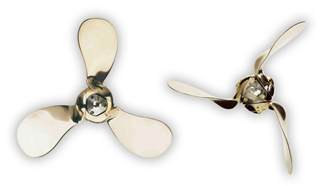Writing this during the 2018 holidays, we see the annual slowdown of marine activities. That’s on the water…but boat owners are turning to maintenance and repairs, preparing for another excellent season on the Puget Sound next year.
Sailors visit Olympic Propeller in Anacortes to restock their zincs, have their props tuned, shafts checked out, and general maintenance questions answered. Inevitably, when a boat has a fixed propeller, the question of folding and feathering props comes up.
Are they worth the extra expense?
Is the difference in performance as advertised, or is it smoke and mirrors?
Are the reverse and prop walk claims for real?
First, let’s look at fixed propellers.
Fixed propellers have been around as long as there’s been boats and propulsion other than the wind. They’ll get you where you’re going, but if your primary propulsion is wind, when they’re not in use they affect your performance…not in a good way!
When sailing, a fixed blade propeller is like tying a line to a 5-gallon bucket handle and throwing it off the transom. If your transmission won’t allow free spin, add another bucket to your drag. Some fixed blade propellers drag is equal to the drag of your entire hull!
Not that a fixed propeller is all bad. They are simple, require less maintenance, and cost substantially less. Like most boat ‘schtuff’, it’s a trade-off.
Once you’ve decided to replace your fixed prop, the next challenge is deciding on folding or feathering. If you have a full-skeg sailboat, you may be limited to feathering props due to space limitations.
The blades of feathering props are designed to rotate, presenting the slim leading edge to the water flow. When under power, the blades rotate to a pre-set angle, providing forward or reverse thrust. Under power is below on the left. On the right, the leading edge cuts through the water when under sail. These props produce an estimated 5-10% of your fixed propellers drag.
A folding prop does just that…the blades fold over the end cap when not in use. The blades are usually geared so the lower blade can’t hang loose, and the blades deploy equally and simultaneously. The folding props drag is low enough to be difficult to measure.
Alright, you’ve decided to replace your fixed propeller. First off, don’t toss it! Put it in a locker, there’s no substitute for a good spare you know works on your boat. Remember, you don’t really need a spare until you need a spare…and then you really need it.
Now it’s time to wade through the manufacturers to decide who is going to make your prop.
Yachting Monthly did an excellent market test several years ago. You can find it here.
One of the main drawbacks to folding and feathering props in their early days was marginal power astern and prop walk, which causes you to wander in reverse. Since Gori’s pioneering in the 70’s the manufacturers have addressed these issues. Most of your options today address SAE, metric and saildrive shafts in many diameters and pitch requirements. And Gori has been joined by FlexoFold, Martec, MaxProp, VariProp, and Volvo Penta, just to name a few.
During the YM test, of the 13 props tested ten of them had superior prop walk compared to a fixed 3-blade prop.
In the astern bollard pull, only two of the thirteen outperformed the 3-blade fixed. But in the stopping time test (which indicates astern power to me, anyway), 6 of the 13 props stopped the boat quicker than the 3-blade fixed. The best performers stopped the boat in less than a boat length.
The folding and feathering props have developed enough that the performance under power is for the most part comparable with a fixed-blade prop. But you didn’t get a sail boat to be motoring, did you?
Here’s where the real crunch is…if you can sail x miles during an eight-hour sail with a folding prop, and the same distance takes twelve hours with a fixed prop, is the price difference worth it? If the noise and vibration you’ve accepted with your fixed blade prop went away, or was significantly reduced, what is that worth? If you can sail in lighter airs by not dragging a bucket behind the boat, will you get more use out of your boat?
These are questions only you can answer. Also, choosing a manufacturer is something only you can do, for your boat and budget.
I would highly recommend checking out the Yachting Monthly article. It details not only comparisons with fixed and folding/feathering propellers, but also compares the folding and feathering choices for price, maintenance, ease of installation etc.
When you’re ready to pull the trigger, see us at the Get a Prop site or give us a call. With over 40 years experience in inboard propellers, we can certainly steer you in the right direction.
We're always interested in your input. Please share your experience on our  and
and  feeds.
feeds.









